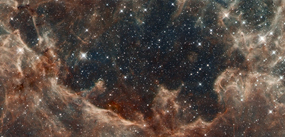Syllabus
Printable syllabus (pdf)
ASTRONOMY 104: UNDERGRADUATE
ASTRONOMY SEMINAR
SYLLABUS
|
|
47750 |
||||||||||
|
|
Wednesdays 2-3 |
||||||||||
|
|
Chris Sneden
|
||||||||||
|
|
none! |
||||||||||
|
|
none! |
||||||||||
|
|
“Who is the program member, |
Introduction
This purpose of this course is to introduce you to our department, to bring you together with fellow astronomy majors, and those in other majors who are keen on astronomy. We hope to discuss present and future pathways to success in and around astronomy, and to share with you some of the exciting instrumental, observational, and theoretical research of our department. The description of Astronomy 104 given in the Undergraduate Catalog is very clear: Designed for astronomy majors. Discussions about current astronomical research, with different topics emphasized each semester. One lecture hour a week for one semester. May be repeated twice for credit when the topics vary. Offered on the pass/fail basis only. Let’s expand on these statements.
Offered on a pass/fail basis only. We want you to enjoy this one credit-hour course; the real academic challenges for you will come in other courses (go study your math & physics!). Therefore it is EASY to do well here; show up for class, participate, and write one simple two-page-limit paper on your contact with an astronomy program member. Your grade will be based on your attendance and your essay. The attendance part is simple: miss no more than two (2) class meetings beginning with the September 2 class. A sign-in sheet will be passed around each class to verify your attendance. The paper is nearly as painless: I ask you to find an astronomy program member of some flavor (faculty member, post-doctoral fellow, research scientist, graduate student, education specialist, engineer, etc.), read some thing that they have written (research paper, equipment design report, StarDate script collection, etc.), talk with that person until you understand their document, and write a no-more-than- two page essay on that person and your interpretation of their work. One restriction: each of you needs to find a different person to interview.
May be repeated twice for credit when the topics vary. Yes indeed; our general theme this fall will be: “Who am I, How Did I Get Here, and Why Does It Make Sense to be at UT?” This somewhat silly title covers my desire for you to be exposed to the quite varied types of people who end up as UT astronomy program members, and their work here. We welcome those of you from past years who have signed up for this course again. Please do note the two-credit limit for the course repetition.
Designed for astronomy majors. All are welcome, no matter what your chosen major is. However, our discussions will assume that astronomy is of much interest to you, and that you are curious about the various aspects of astronomy research. But not to worry: we do understand that most of you are just beginning your academic exploration of astronomy, and the discussions will not assume graduate-student knowledge of the field.
Preliminary Course Schedule
Here we list the class meeting dates and those activities that have been scheduled so far. Please take this as subject to change, as we juggle the schedules of the class guests.
|
DATE |
LEADER |
|
|
|
Chris Sneden |
Introduction to our Program |
|
|
Milos Milosavljevic, |
Introduction to the Department |
|
|
Anita Cochran |
|
|
|
Harriet Dinerstein |
|
|
|
Fritz Benedict |
|
|
|
Neal Evans |
|
|
|
Steve Finkelstein |
|
|
|
Mary Kay Hemenway, |
Education & Outreach, ... |
|
|
Mike Endl |
|
|
|
Erik Brugamyer |
|
|
|
Phillip MacQueen |
|
|
|
Don Winget |
|
|
|
TBA |
|
|
|
Mike Montgomery |
|
|
|
Shardha Jogee |
|

Tarantula Nebula [ESO/STScI]
Professor
RLM 17.206 · (512) 471-1349 · email
Home Phone:
434-0004
Office Hours
TBA